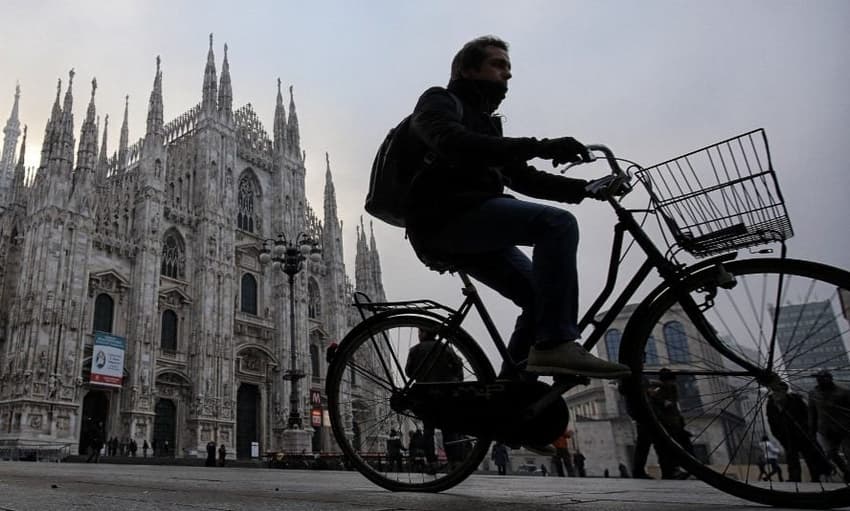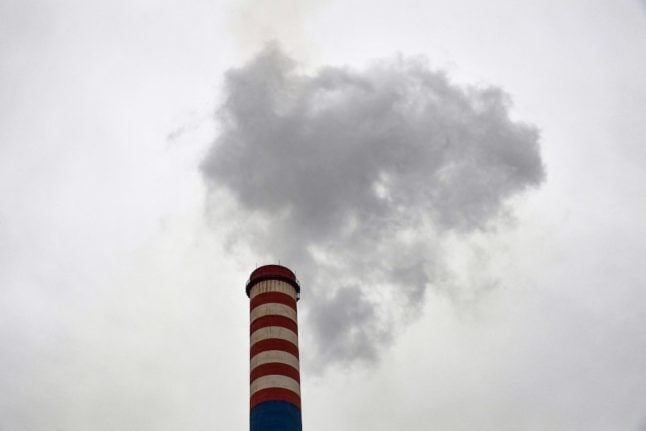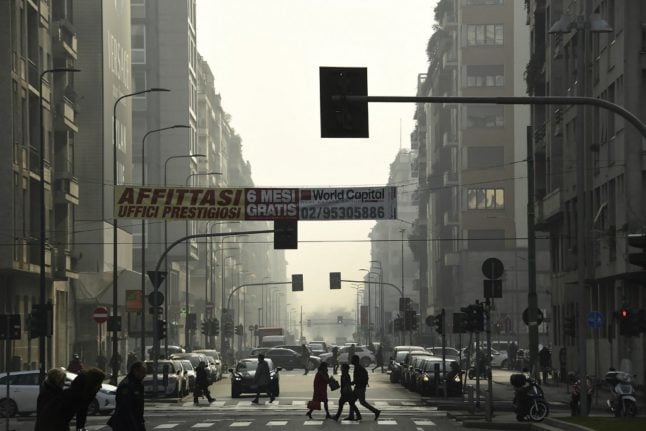REVEALED: These are the most polluted towns in Italy

The northern cities of Milan and Turin were named Italy's 'smog capitals' in a new pollution report on Monday which urged the government to take action over poor air quality.
Smog and pollution are choking Italian cities year-round and many towns are exceeding limits on fine particles and other pollution, according to another report from Italian environmental watchdog Legambiente.
The Mal’aria di città (Air pollution in the city) report for 2023, unveiled on Monday, was the latest to warn about the risks to health posed by pollution in many parts of the country.
It found that 25 of 95 cities monitored had violated clean air ordinances by exceeding daily fine particle (PM10) emission limits, which are currently set at no more than 35 days a year with a daily average of over 50 micrograms per cubic metre.
Turin was ranked as the worst offender, exceeding this level on 90 days, closely followed by Milan (84), Asti (79), Modena (75), and Padua and Venice at 70.
These were followed by Cremona, Treviso, Mantua and Rovigo, all of which exceeded limits to a lesser degree.
All of the most polluted cities were in the northern Italian regions of Piedmont, Lombardy, Emilia Romagna and Veneto, with most within the north-western ‘industrial triangle’.
Some southern cities featured nearer the bottom of the ranking, with Andria (Puglia) and Ragusa (Sicily) exceeding limits on several days, as well as Rome, which overshot the permitted level for one day.

(Photo by Andreas SOLARO / AFP)
The average annual rate of PM10 emissions nationwide dropped slightly, by two percent year-on-year, the report found.
"This, however, is not enough to guarantee the health of citizens,” said Stefano Ciafani, president of Legambiente.
He pointed out that the situation looked even worse if air quality in Italian cities were measured against tighter limits under the new European Directive on air quality, in force from 2030, which lowers the PM10 threshold from 35 to 20 micrograms per cubic meter of air.
“Only 23 out of 96 cities (24 percent) would be under these limits,” Ciafani said, while 84 percent would exceed the threshold for PM2.5 and 61 percent for nitrogen dioxide (NO2).
Italy has repeatedly been reprimanded by the European Union over air quality, and has “persistently and systematically” breached EU recommended limits, the European Court of Justice ruled in 2020.
The north of Italy has long been ranked among the worst areas in Europe for polluted air according to data from the European Environment Agency.
"Air pollution is not only an environmental problem, but also a health problem of great importance,” said Ciafani. “In Europe, it’s the main cause of premature death due to environmental factors.”
“Italy has more than 52,000 deaths per year caused by PM2.5 emissions, equal to a fifth of those recorded throughout the continent," he said.
The main causes of air pollution in Italian cities are reported to be industry, inefficient domestic heating systems, agricultural practices and, most of all, heavy traffic.
In Italy, cars continue to be by far the most-used means of transport. 65.3 percent of journeys overall are made by car, Legambiante wrote, with the emissions from some 38 million cars choking Italy’s towns and cities.

(Photo by Miguel MEDINA / AFP)
Legambiente said “drastic” measures were required to tackle the problem, including funds for more efficient heating systems in homes and public buildings and a major increase in public transport provision.
The group said Italy must “quadruple the availability of public transit, promoting integrated season tickets as done by Germany in 2022”, triple the number of electric buses, create zero-emission zones in town centres, and “create another 16,000 kilometres of cycle paths”.
It also praised local authorities choosing to bring in 30 km/h speed limits in city centres. Councils in Bologna, Turin, Milan and Cesena have all said they plan to implement these limits, following the lead of European cities including Paris and Madrid, despite fierce criticism from Italian transport minister Matteo Salvini.
Legambiente published a petition urging the government to make clean air and more livable cities a priority, saying Italy should follow Paris in attempting to create '15-minute cities', in which everyone lives within a quarter of an hour's walk of vital amenities such as shops and schools and possibly also workplaces.
Comments
See Also
Smog and pollution are choking Italian cities year-round and many towns are exceeding limits on fine particles and other pollution, according to another report from Italian environmental watchdog Legambiente.
The Mal’aria di città (Air pollution in the city) report for 2023, unveiled on Monday, was the latest to warn about the risks to health posed by pollution in many parts of the country.
It found that 25 of 95 cities monitored had violated clean air ordinances by exceeding daily fine particle (PM10) emission limits, which are currently set at no more than 35 days a year with a daily average of over 50 micrograms per cubic metre.
Turin was ranked as the worst offender, exceeding this level on 90 days, closely followed by Milan (84), Asti (79), Modena (75), and Padua and Venice at 70.
These were followed by Cremona, Treviso, Mantua and Rovigo, all of which exceeded limits to a lesser degree.
All of the most polluted cities were in the northern Italian regions of Piedmont, Lombardy, Emilia Romagna and Veneto, with most within the north-western ‘industrial triangle’.
Some southern cities featured nearer the bottom of the ranking, with Andria (Puglia) and Ragusa (Sicily) exceeding limits on several days, as well as Rome, which overshot the permitted level for one day.

The average annual rate of PM10 emissions nationwide dropped slightly, by two percent year-on-year, the report found.
"This, however, is not enough to guarantee the health of citizens,” said Stefano Ciafani, president of Legambiente.
He pointed out that the situation looked even worse if air quality in Italian cities were measured against tighter limits under the new European Directive on air quality, in force from 2030, which lowers the PM10 threshold from 35 to 20 micrograms per cubic meter of air.
“Only 23 out of 96 cities (24 percent) would be under these limits,” Ciafani said, while 84 percent would exceed the threshold for PM2.5 and 61 percent for nitrogen dioxide (NO2).
Italy has repeatedly been reprimanded by the European Union over air quality, and has “persistently and systematically” breached EU recommended limits, the European Court of Justice ruled in 2020.
The north of Italy has long been ranked among the worst areas in Europe for polluted air according to data from the European Environment Agency.
"Air pollution is not only an environmental problem, but also a health problem of great importance,” said Ciafani. “In Europe, it’s the main cause of premature death due to environmental factors.”
“Italy has more than 52,000 deaths per year caused by PM2.5 emissions, equal to a fifth of those recorded throughout the continent," he said.
The main causes of air pollution in Italian cities are reported to be industry, inefficient domestic heating systems, agricultural practices and, most of all, heavy traffic.
In Italy, cars continue to be by far the most-used means of transport. 65.3 percent of journeys overall are made by car, Legambiante wrote, with the emissions from some 38 million cars choking Italy’s towns and cities.

Legambiente said “drastic” measures were required to tackle the problem, including funds for more efficient heating systems in homes and public buildings and a major increase in public transport provision.
The group said Italy must “quadruple the availability of public transit, promoting integrated season tickets as done by Germany in 2022”, triple the number of electric buses, create zero-emission zones in town centres, and “create another 16,000 kilometres of cycle paths”.
It also praised local authorities choosing to bring in 30 km/h speed limits in city centres. Councils in Bologna, Turin, Milan and Cesena have all said they plan to implement these limits, following the lead of European cities including Paris and Madrid, despite fierce criticism from Italian transport minister Matteo Salvini.
Legambiente published a petition urging the government to make clean air and more livable cities a priority, saying Italy should follow Paris in attempting to create '15-minute cities', in which everyone lives within a quarter of an hour's walk of vital amenities such as shops and schools and possibly also workplaces.
Join the conversation in our comments section below. Share your own views and experience and if you have a question or suggestion for our journalists then email us at [email protected].
Please keep comments civil, constructive and on topic – and make sure to read our terms of use before getting involved.
Please log in here to leave a comment.